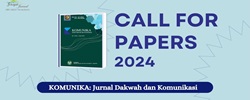Author Guidelines
- The submission has not been previously published in full text or part of it.
- The submission is original, neither a compilation nor a translation.
- The length of the manuscript sent to us is 4000-7000 words, including a bibliography.
- To write the complete article, refer to the template you can download here.
- For the manuscript in Bahasa Indonesia, please use Ejaan Yang Disempurnakan 5th edition, which can be accessed here.
- Arabic Transliteration guidelines can be downloaded here.
- The submission is a critical review and empirical research focusing on Da'wa and Communication, which covers:
- Da'wa Media;
- Da'wa Strategy and Method;
- Da'wa Organisation and Management;
- Da'wa and Politics;
- Da'wa History and Thought;
- Islamic Communication;
- Islamic Broadcasting;
- Journalism;
- Communication Theory;
- Mass Communication;
- New Media Studies.
- Empirical research-based manuscripts use formats: Introduction, Research Method, Results and Findings, Discussions, Conclusions, and Future Work.
- Introduction: consists of background problems, a brief literature review, research questions, and objectives.
- Research Method: consists of the type of research, subject and object, data collection techniques, data analysis techniques, location, and research time.
- Results and Findings: contains brief data presentation, analysis, and research findings that contribute to the development of da'wah and communication. It contains the analysis based on the research question.
- Discussion: contains an understanding of the findings and a comparison with the theory and/or similar research.
- Conclusion: the conclusion is not a summary of the manuscript. Conclusion. The conclusion consists of the answer to the research question(s) or the main discussion points.
- Critical Review-based and idea/conceptual study format: Introduction, Summary, Critique, and Conclusion.
- Introduction: The length of an introduction is usually one paragraph for a journal article review and two or three paragraphs for a longer book review. Include a few opening sentences that announce the author(s) and the title and briefly explain the topic of the text. Present the aim of the text and summarise the main findings or key arguments. Conclude the introduction with a brief statement of your evaluation of the text. This can be a positive or negative evaluation or, as is usually the case, a mixed response.
- Summary: Present a summary of the key points and a limited number of examples. You can also briefly explain the author's purpose/intentions throughout the text, and you may briefly describe how the text is organized. The summary should only make up about a third of the critical review.
- Critique: The critique should be a balanced discussion and evaluation of the text's strengths, weaknesses, and notable features. Remember to base your discussion on specific criteria. Good reviews also include other sources to support your evaluation (remember to reference).
You can choose how to sequence your critique. Here are some examples to get you started:
- The most important to least important conclusions you make about the text.
- If your critique is more positive than negative, present the negative points first and the positive last.
- If your critique is more negative than positive, present the positive points first and the negative last.
- If there are both strengths and weaknesses for each criterion you use, you need to decide overall what your judgment is. For example, you may want to comment on a key idea in the text and have positive and negative comments. You could begin by stating what is good about the idea and then concede and explain how it is limited in some way. While this example shows a mixed evaluation, you are probably more negative than positive overall.
- In long reviews, you can address each criterion you choose in a paragraph, including negative and positive points. For very short critical reviews (one page or less) where your comments will be briefer, include a paragraph of positive aspects and another of negative.
- You can also include recommendations for improving the text regarding ideas and research approaches; theories or frameworks can also be included in the critique section.
- Conclusion: This is usually a very short paragraph.
- Restate your overall opinion of the text.
- Briefly present recommendations.
- Further qualifications or an explanation of your judgment can be included if necessary. This can help your critique sound fair and reasonable.
- Before submitting an article, the main author completes and signs the publication ethics statement. the form can download here. Also, fill out the curriculum vitae form, which can be downloaded here.
- The manuscript must be submitted via the OJS system.
- First, the author should register as either an author or reviewer (checking role as author or reviewer) in the Register.
- Once the registration step is complete, log in as an author and click on New Submission. The article submission stage consists of five stages: (1). Start, (2). Upload Submission, (3). Enter Metadata, (4). Upload Supplementary Files, (5). Confirmation.
- In the "Start" column, choose Journal Section (Full Article), and check all the checklists.
- In the "Upload Submission" Columns, upload the manuscript files in MS. Word format in this column.
- In the "Enter Metadata" columns, fill in all the author data and affiliations. Include the Article Title, Abstract, and Indexing Keywords.
- In the Upload Supplementary Files columns, the author can upload supplementary files, the Publication Ethics Statement and Curriculum Vitae (at number 9 above), or any other. Publication Ethics Statement can be downloaded here., also fill out the curriculum vitae form, which can be downloaded here.
- In the Confirmation columns, if the data you entered is correct, click Finish Submission.
- If the author has difficulties submitting through the online system, please get in touch with the Komunika: Jurnal Dakwah dan Komunikasi editorial team at [email protected].
- The incoming manuscript will check the similarity using iThenticate with a maximum tolerance of 20%. If the results show more than 20%, the manuscript will be returned to be improved by the author.




















